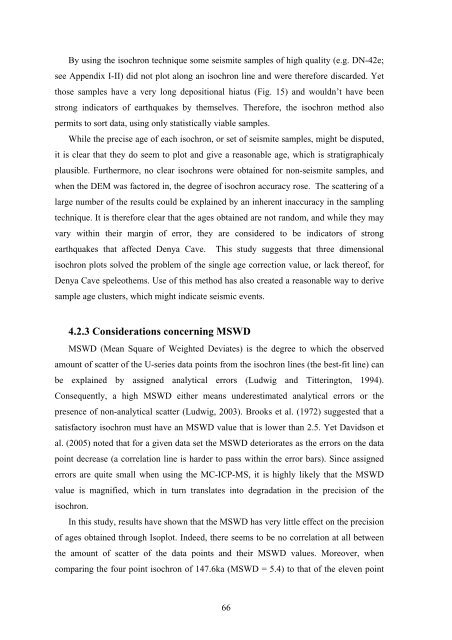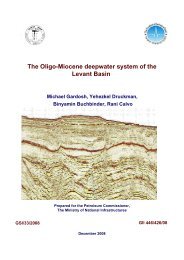tivity on the carmel faul
tivity on the carmel faul
tivity on the carmel faul
You also want an ePaper? Increase the reach of your titles
YUMPU automatically turns print PDFs into web optimized ePapers that Google loves.
By using <strong>the</strong> isochr<strong>on</strong> technique some seismite samples of high quality (e.g. DN-42e;<br />
see Appendix I-II) did not plot al<strong>on</strong>g an isochr<strong>on</strong> line and were <strong>the</strong>refore discarded. Yet<br />
those samples have a very l<strong>on</strong>g depositi<strong>on</strong>al hiatus (Fig. 15) and wouldn’t have been<br />
str<strong>on</strong>g indicators of earthquakes by <strong>the</strong>mselves. Therefore, <strong>the</strong> isochr<strong>on</strong> method also<br />
permits to sort data, using <strong>on</strong>ly statistically viable samples.<br />
While <strong>the</strong> precise age of each isochr<strong>on</strong>, or set of seismite samples, might be disputed,<br />
it is clear that <strong>the</strong>y do seem to plot and give a reas<strong>on</strong>able age, which is stratigraphicaly<br />
plausible. Fur<strong>the</strong>rmore, no clear isochr<strong>on</strong>s were obtained for n<strong>on</strong>-seismite samples, and<br />
when <strong>the</strong> DEM was factored in, <strong>the</strong> degree of isochr<strong>on</strong> accuracy rose. The scattering of a<br />
large number of <strong>the</strong> results could be explained by an inherent inaccuracy in <strong>the</strong> sampling<br />
technique. It is <strong>the</strong>refore clear that <strong>the</strong> ages obtained are not random, and while <strong>the</strong>y may<br />
vary within <strong>the</strong>ir margin of error, <strong>the</strong>y are c<strong>on</strong>sidered to be indicators of str<strong>on</strong>g<br />
earthquakes that affected Denya Cave. This study suggests that three dimensi<strong>on</strong>al<br />
isochr<strong>on</strong> plots solved <strong>the</strong> problem of <strong>the</strong> single age correcti<strong>on</strong> value, or lack <strong>the</strong>reof, for<br />
Denya Cave speleo<strong>the</strong>ms. Use of this method has also created a reas<strong>on</strong>able way to derive<br />
sample age clusters, which might indicate seismic events.<br />
4.2.3 C<strong>on</strong>siderati<strong>on</strong>s c<strong>on</strong>cerning MSWD<br />
MSWD (Mean Square of Weighted Deviates) is <strong>the</strong> degree to which <strong>the</strong> observed<br />
amount of scatter of <strong>the</strong> U-series data points from <strong>the</strong> isochr<strong>on</strong> lines (<strong>the</strong> best-fit line) can<br />
be explained by assigned analytical errors (Ludwig and Titteringt<strong>on</strong>, 1994).<br />
C<strong>on</strong>sequently, a high MSWD ei<strong>the</strong>r means underestimated analytical errors or <strong>the</strong><br />
presence of n<strong>on</strong>-analytical scatter (Ludwig, 2003). Brooks et al. (1972) suggested that a<br />
satisfactory isochr<strong>on</strong> must have an MSWD value that is lower than 2.5. Yet Davids<strong>on</strong> et<br />
al. (2005) noted that for a given data set <strong>the</strong> MSWD deteriorates as <strong>the</strong> errors <strong>on</strong> <strong>the</strong> data<br />
point decrease (a correlati<strong>on</strong> line is harder to pass within <strong>the</strong> error bars). Since assigned<br />
errors are quite small when using <strong>the</strong> MC-ICP-MS, it is highly likely that <strong>the</strong> MSWD<br />
value is magnified, which in turn translates into degradati<strong>on</strong> in <strong>the</strong> precisi<strong>on</strong> of <strong>the</strong><br />
isochr<strong>on</strong>.<br />
In this study, results have shown that <strong>the</strong> MSWD has very little effect <strong>on</strong> <strong>the</strong> precisi<strong>on</strong><br />
of ages obtained through Isoplot. Indeed, <strong>the</strong>re seems to be no correlati<strong>on</strong> at all between<br />
<strong>the</strong> amount of scatter of <strong>the</strong> data points and <strong>the</strong>ir MSWD values. Moreover, when<br />
comparing <strong>the</strong> four point isochr<strong>on</strong> of 147.6ka (MSWD = 5.4) to that of <strong>the</strong> eleven point<br />
66

















